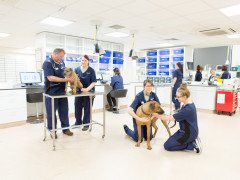Head of talent Jacqui gives practical advice to job seekers in the veterinary professions
At this time of year, graduates are moving on from the world of education and trying to find work for the first time.
Taking the first steps towards job hunting, building a network, creating a CV, applying for roles and undertaking interviews can be daunting.
It used to be that only the ‘demand’ side of the employment market was well structured.
Employers advertised their jobs, candidates had a look at what was posted – traditionally this was only in printed publications – and then applied to the adverts that appealed to them most.
Now the ‘supply’ side of the market has become organised, too.
In this month’s blog from the talent team, head of talent Jacqui Todd explains how to set up a LinkedIn profile and why creating a professional network at the very beginning of your career journey is essential for success.

Interested in joining our team?
If working out of hours appeals to you, check out our current job opportunities.
Find out moreSocial media platforms like LinkedIn offer a ‘real-time’ bank of talent that’s constantly searchable and provides a mode of contact for headhunting. Prospective candidates and employers share the same space. The best recruiters are taking advantage of this to beat their competition to top talent.
LinkedIn is a professional ‘Facebook’, a way of searching for relevant industry professionals, connecting with them to obtain a mode of contact, and giving them visibility of anything you share.
For recruiters, it’s essentially a database of CVs and that’s why having a professional LinkedIn profile is so important for anyone with ambitions to make the most of their potential.
The latest data shows that 94% of recruiters now use social media in their recruitment efforts. This spans all sectors and all skill levels. Here six top tips to effectively boost your LinkedIn profile.

Setting up a LinkedIn profile:
1. Picture
The picture should be a simple headshot. It should be professional, but it doesn’t have to be boring or artificial. People remember faces more than names.
2. Headline
You have 120 characters at the top of your profile to describe to the world what you do. Choose descriptive, searchable and industry recognisable terms, keywords that help you get found by the right people. Remember, LinkedIn is a search engine.
3. Summary
It is well worth the effort of writing a captivating summary section. This is your “elevator speech”. These are the first sentences people read, and you have a very short time to ensure your audience capture key information about you that is genuine and can be evidenced.
4. Experience
This is the body of your profile – just like on a traditional CV, where you showcase your experience, expertise, and skills. You add where you have worked, for how long, and in what roles and functions. Include your current position and at least two other positions.
5. Keywords and search engine optimisation
Include keywords everywhere, especially in the summary and experience sections, for search engine optimization (SEO) purposes. When people use LinkedIn, they use certain industry-specific keywords. These are the terms that will help you show up in search results. vet nurse, vet surgeon, emergency and critical care, out of hours, and RCVS are some examples.
6. Groups and associations
Groups are a way to build relationships and network with people who are doing similar work or have similar interests as you. You have about 1.3 million groups on LinkedIn to choose from. Join as many relevant groups as you can and contribute to the conversation. As a start, join the alumni groups for where you went to school and any industry association groups pertinent to your line of work.
For any advice on creating a CV or preparing for an interview process, please contact the Vets Now Talent team on Talent Team

